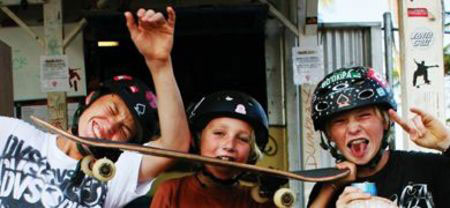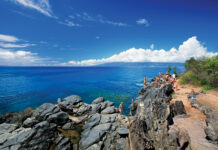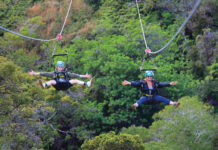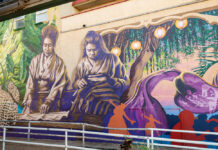Story by Jason Hilford | Photography by Nina Lee
 Within its colorfully graffitied walls, Stonewave is a freestyle skateboarder’s dream, a seamless sea of concrete bowls that gives young skaters a chance to be their rebellious selves in a safe, supervised environment. Beneath the surface thrills, Stonewave is a pure reflection of the center’s nine Hawaiian values, which include le‘a le‘a (fun), malama (to care for, serve, honor), lokahi (unity), ‘ohana (family) and kuleana (personal responsibility). When Stonewave was under construction, local youth volunteered to help break ground and transport building materials. Since then, members have run their park: opening and closing, sweeping, registering new members, and handling money. “It’s teaching me what it’s like to have a job,” says one sixteen-year-old.
Within its colorfully graffitied walls, Stonewave is a freestyle skateboarder’s dream, a seamless sea of concrete bowls that gives young skaters a chance to be their rebellious selves in a safe, supervised environment. Beneath the surface thrills, Stonewave is a pure reflection of the center’s nine Hawaiian values, which include le‘a le‘a (fun), malama (to care for, serve, honor), lokahi (unity), ‘ohana (family) and kuleana (personal responsibility). When Stonewave was under construction, local youth volunteered to help break ground and transport building materials. Since then, members have run their park: opening and closing, sweeping, registering new members, and handling money. “It’s teaching me what it’s like to have a job,” says one sixteen-year-old.
The Pāʻia Youth & Cultural Center began in 1993, when Mauians Lynn Rasmussen, Alice Lee, and Brian McAfferty leased a fire-damaged former plantation house at Pa‘ia Bay and set about establishing a grassroots, nonprofit organization for North Shore youth. Today that renovated structure houses a restaurant-style kitchen and café, radio station and media lab. Center membership is free, except for the skate park, whose maintenance fee is an affordable-even-for-a-broke-teenager $20 per year. A five-day pass is $5.
Despite its idyllic setting, the North Shore presents real difficulties for its youngest residents—from a high rate of single-parent households, to readily available drugs and alcohol, to the familiar pitfalls of idle hands. “Every kid that grew up in Pa‘ia has been involved in the center,” says one teenaged girl. “If not, God knows what they’d be doing.”
Working the front and the back of the house, members serve up healthy ono food at the center’s Pāʻia Bay Cafe. Good thing—all that play builds quite an appetite!
In addition to providing a safe, tobacco-, alcohol-, and drug-free zone for youth, the center encourages a healthy lifestyle. Youngsters can drop by the center’s kitchen for a do-it-yourself snack that’s nutritious—and free. Program specialist Ben Rachunas, who teaches cooking here, volunteers at local farms, where he frequently asks for donations of surplus fruit. (As soon as the farmers find out it’s for the center, he says, he has more than he wants.)
Members can also take cooking courses and learn the foodservice trade. The Pa‘ia Bay Café, which operates out of the kitchen and sells food prepared by members, is open to the beachgoing public on Fridays and Saturdays. The kids recently developed their own chocolate and packaging, and are working on licensing it and finding a producer. Susun White, executive director, says these programs support the center’s goal of creating a secure environment and creative outlets, while teaching kids marketable skills and entrepreneurship.
Marlon Tumacder was an early center member. “It became like a second home and family for me,” says the twenty-seven-year-old Pāʻia native. “I liked how they listened to the kids’ ideas.”
Tumacder wasn’t exactly a model citizen in the beginning. (“One of his first contributions to the center, when he was ten, was to start a fire inside of it,” laughs Emma Phelps-Conant, the center’s drop-in coordinator.) But soon he was making the most of its resources—especially the center’s Hekili Multimedia Lab, which ignited in Tumacder a passion for videography. What started with “a bunch of us just grabbing a camera and filming each other in the water” turned into a full range of surfing and bodyboarding films.
Hekili Lab occupies a front room in the old plantation house. The day I visit, lab manager Peter Swanzy is recording a petite blond girl as she sings a pop song. Soundproofed, with an impressive array of recording equipment, the room has the look and feel of a professional studio. Through workshops and one-on-one instruction, the lab offers Web design, video production, and music composition and recording.
In a tiny room on the second floor, RadioPio broadcasts a 100-watt signal—and a big aspiration to combine creative expression, a sense of ownership and fun. “You wouldn’t believe how many kids have been here,” laughs program director and former Mana‘o Radio deejay Laura Civitello. Members choose the music (anything broadcast-appropriate goes), staff the microphone, and originate show ideas, among them Windsurf Talk Story—a call-in show on Maui’s signature water sport—and an environmental series on the effects of plastic.
***
Besides providing a safe hangout—one that’s open till 9 p.m. most evenings—Pāʻia Youth & Cultural Center offers a multitude of programs and activities for kids: yoga instruction, surf trips, sleepovers, and movie nights, to name a few. It operates on a stunningly focused mission of molding those whom it sees as the future of the island—and does so by answering the basic need kids have for something to do.
“We’re not here to help, fix, or promote the community,” says Rasmussen, a board member. “We’re here to be the community.”





